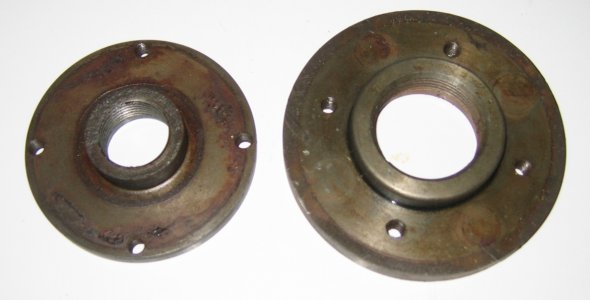- Joined
- Oct 31, 2016
- Messages
- 2,719
I recently got an 8" 4 jaw chuck. The backing plate on the chuck has 2 3/8 x 8 tpi threads. The spindle on my lathe is 1 1/2 x 8 tpi. Here are the backing plates off my old and new chucks

The outside diameter is not critical. The raised center section is a very tight fit in both chucks. I think that this is a what keeps the chuck true to the backing plate. I was hoping that the diameter of the bolt circle would be the same but they are not. The bolt circle diameter of my old chuck is 0.120 bigger than the new chuck. Too many choices and don't know which path to follow.
The easiest would be to make a simple adapter with 1 1/2 x 8 tpi on the inside and 2 3/8 x 8 tpi on the outside. I have a piece of 3" round bar that I could make the adapter out of.
Using what I have on hand I thought of drilling and taping news holes in the old backing plate and making a bushing to fit between the raised center section of the old backing plate and the hole in the new chuck. This is the least desirable alternative because I would not be able to use the old chuck.
Or I could make a new backing plate with 1 1/2 x 8 tpi that fits the new chuck. I would have to buy a piece of round bar 5" diameter x 1" thick. That would probably cost me more than what I paid for the chuck when you add in the cost of shipping. I bought the chuck at an auction for $40.
What are the pros and cons of my choices?

The outside diameter is not critical. The raised center section is a very tight fit in both chucks. I think that this is a what keeps the chuck true to the backing plate. I was hoping that the diameter of the bolt circle would be the same but they are not. The bolt circle diameter of my old chuck is 0.120 bigger than the new chuck. Too many choices and don't know which path to follow.
The easiest would be to make a simple adapter with 1 1/2 x 8 tpi on the inside and 2 3/8 x 8 tpi on the outside. I have a piece of 3" round bar that I could make the adapter out of.
Using what I have on hand I thought of drilling and taping news holes in the old backing plate and making a bushing to fit between the raised center section of the old backing plate and the hole in the new chuck. This is the least desirable alternative because I would not be able to use the old chuck.
Or I could make a new backing plate with 1 1/2 x 8 tpi that fits the new chuck. I would have to buy a piece of round bar 5" diameter x 1" thick. That would probably cost me more than what I paid for the chuck when you add in the cost of shipping. I bought the chuck at an auction for $40.
What are the pros and cons of my choices?
